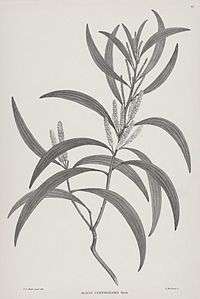Banks' Florilegium

Banks' Florilegium is a collection of copperplate engravings of plants collected by Sir Joseph Banks and Daniel Solander while they accompanied Captain James Cook on his voyage around the world between 1768 and 1771. They collected plants in Madeira, Brazil, Tierra del Fuego, the Society Islands, New Zealand, Australia and Java.
Banks' and Solander's specimens were studied aboard the HM Bark Endeavour by Sydney Parkinson. He drew each specimen and made notes on their colour, and for some species he completed watercolour illustrations. When they returned to London, Banks hired 5 artists to create watercolours of all of Parkinson's drawings. Between 1771 and 1784 Banks hired 18 engravers to create the copperplate line engravings from the 743 completed watercolours at a considerable cost. The Florilegium was not printed in Banks' lifetime and he bequeathed the plates to the British Museum.
Some of the plates were eventually printed. Between 1900 and 1905, James Britten and the British Museum issued prints of 315 of the plant engravings in black ink, under the title Illustrations of Australian Plants. Others were included in black and white in the 1973 book Captain Cook's Florilegium. The first complete full-colour edition of the Florilegium was published between 1980 and 1990 in 34 parts by Alecto Historical Editions and the British Museum (Natural History). Only 100 sets were made available for sale, some on a subscription basis. The plates were printed using a 17th-century technique known as à la poupée where each colour was applied directly to the plate, colour accuracy was checked against Parkinson's notes and through consultation with the Museum's Botanical Editor, Chris Humphries. Each plate took from one week to two months to proof. Chris Humphries worked closely with his colleague, the Botany Librarian Judith Diment, as well as the printers led by Edward Egerton-Williams, the typesetters led by Ian Mortimer and colleagues at Alecto Historical Editions including Nigel Frith, Laurence Hoffman and Elaine Shaughnessy. Parts 1 to 15 consist of 337 plates relating to the Australian flora, parts 16 to 34 include Brazil, Madeira, New Zealand, Java, Society Islands and Tierra del Fuego. Banks’ Florilegium is the world’s largest 20th-century fine art printing project and has been exhibited all over the world.
A documentary recounting the journey and the publication of the Florilegium, Banks' Florilegium: The Flowering of the Pacific, was released in 1984. It was narrated by Australian Robert Hughes. A book on the subject, The flowering of the Pacific: Being an account of Joseph Banks' travels in the South Seas and the story of his Florilegium, by Brian Adams was published by the British Museum in 1986.
References
- Judith A. Diment, Christopher J. Humphries, Linda Newington & Elaine Shaughnessy. Catalogue of the natural history drawings commissioned by Joseph Banks on the Endeavour voyage 1768–1771 held in the British Museum (Natural History), Part I: Botany: Australia (Bulletin of the British Museum (Natural History) Historical Series Volume 11), London, 1984.
- Judith A. Diment, Christopher J. Humphries, Linda Newington & Elaine Shaughnessy. Catalogue of the natural history drawings commissioned by Joseph Banks on the Endeavour voyage 1768–1771 held in the British Museum (Natural History), Part 2: Botany: Brazil, Java, Madeira, New Zealand, Society Islands and Tierra del Fuego (Bulletin of the British Museum (Natural History) Historical Series Volume 12), London, 1987.